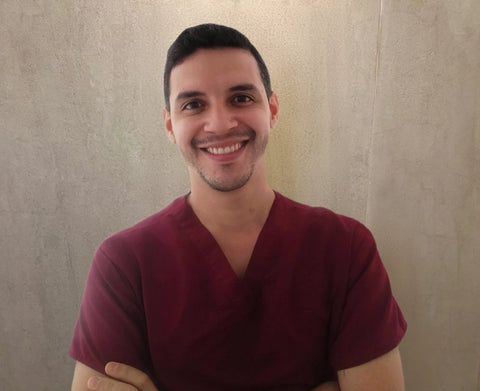The Science of Immediate Loading: When Is It Safe and What Makes It Work?
Improving Implant Dentistry with Immediate Loading
After decades of continuous improvements in implant dentistry, it was a matter of time for “controversial” protocols to become standards in modern esthetic procedures. In today’s dentistry, we must restore function and aesthetics effectively but quickly. Fortunately, this is the case for immediate loading implants.
Nowadays, immediate loading is a well-documented, evidence-based, and viable protocol under the appropriate clinical conditions. This informative article explores the science behind immediate loading, focusing on key factors to improve success rates while offering our insight on the topic through our clinical setting in the U.S. and Latin America.
Defining Immediate Loading: Clinical Context
What Do We Mean By Immediate Loading?
The literature defines immediate loading as the placement of a prosthetic device, whether permanent or temporary, within 48-72 hours after implant placement. In contrast, other protocols like early and conventional loading require two, three, or more months to allow prosthetic restoration.
However, the success and predictability of this clinical protocol depend on creating biomechanical conditions that lead to primary stability and undisturbed osseointegration to achieve the desired rapid function.
Brief Historical Perspective
Looking back, we find that immediate loading was initially met with skepticism and some controversy. However, it has earned its place through rigorous studies and clinical refinement. From implant surface treatment to clinical planning, and prosthetically driven restorations, Brånemark's original protocols have evolved to adapt to modern standards and patient specific needs.

Biomechanical Principles That Support Immediate Loading
Primary Stability
Stability is the base of osseointegration. An unstable prosthetic restoration is doomed to failure, independently of the surgical protocol, post placement, or complementary regenerative techniques applied. As a result, achieving primary stability is a fundamental requirement in immediate loading.
For immediate loading, we aim for torque values of approximately 35 N/cm to monitor the Implant Stability Quotient (ISQ) through resonance frequency analysis. The values ISQ are recommended to stay above 65. Those measures allow us to keep the micromotion threshold below 100–150 μm, preventing the risk of fibrous encapsulation instead of the desired osseointegration.

Day 1–2 peri-implant healing phase showing initial clot formation, growth factor release, and early migration of osteogenic cells.

Day 3–4 peri-implant bone remodeling showing osteoblast activation, necrotic bone resorption, and new bone deposition.

Weeks 4–12 peri-implant healing showing maturation into lamellar bone and establishment of implant osseointegration.
Bone Quality
Good bone quality is another crucial requirement. We need bone that can at least withstand the previously mentioned 35 N/cm. The quantity is also essential as most implant posts needed for immediate loading are approximately 10 mm long, aiding in primary stability.
Additionally, recent studies have shown that immediate loading benefits more from dense cortical bone, whether D1 or D2, than softer trabecular bone (D3 or D4).
Implant Design
Our choice for implant design at GDT Dental Implants is a depth, macrogeometry, and body taper that complements the bone type of the patient. Also, using surface treatments like Sandblasted, Large-grit, Acid-etched (SLA) or Resorbable Blast Media (RBM) implants has proven to increase bone-to-implant contact by creating surface roughness and increasing the contact area. These techniques play a vital role in accelerating osseointegration and reducing the window of vulnerability for possible complications.
When Are Patients Eligible for Immediate Loading
Clinical Parameters for Success
Before rehabilitating with immediate loading, we must assess multiple factors that go beyond ISQ and torque. We must also guide our attention to bone density at the post site, the proximity of anatomical structures, and the potential need for additional procedures like bone grafting, sinus lifting, or guided bone regeneration.
These crucial steps are even more critical when we rehabilitate missing teeth in the anterior zone due to the esthetic constraints, as soft tissue outcomes and emergency profiles become as imprescindible as prosthetic mechanical stability.
Patient-related Factors to Consider
Just as with any other surgical intervention, patient selection while understanding individual risk factors is crucial to achieving a predictable and successful rehabilitation. Among the most relevant factors to consider we can find:
- Smoking: Still considered the worst enemy in implantology and a significant hazard for any specialist out there.
- Uncontrolled Diabetes: Detecting early signs of the disease if not properly diagnosed or medically controlled is a must in immediate loading implantology.
- Parafunctional Habits: These harmful habits, such as bruxism, will eventually lead to mobility and TMJD if not corrected.
- Occlusion: Studying patients’ occlusion, possible alterations, vertical dimension, and understating occlusal load is a must during the planning of this protocol.
Surgical and Prosthetic Protocols for Immediate Loading
Surgical Aids Aimed at Maximizing Primary Stability
The surgical approach directly influences mechanical stability and the success rate of the rehabilitation. Literature reports the possibility of underprepare the osteotomy to maximize the final torque in patients with high bone density. However, for cases with softer bone, we must opt for wider implants or consider a tapered design to maximize ISQ values.
Additionally, we try to opt for flapless surgery whenever feasible to preserve blood supply and enhance healing without risking post-surgery contamination and other complications. The use of 3D planning, customized surgical drilling guides, FRP, PRP, and xenografts are highly valuable tools to implement when feasible or necessary.
Patient compliance is also essential to avoid functional loading on the implant during the initial healing phase. Moreover, excellent oral hygiene and the appropriate diet restrictions are non-negotiable.
Prosthetic Considerations
In the case of full-arch restorations, the research suggests considering splint implants to distribute the occlusal load and reduce micromotion during recovery. Furthermore, we must ensure a passive fit and have occlusal control to start considering successful outcomes.
On the other hand, screw-retained provisionals allow considerably easy retrieval and adjustment when needed while reducing bleeding and probing.
Lastly, when analyzing occlusal contacts, we try to avoid centric points on single-unit immediate restoration to reduce overload risk. Multiple units handle centric contacts considerably safer as long as we maintain a passive fit and patient cooperation during osseointegration.
Evidence-Based Success Rates
Recent data shows that immediate loading has a success rate comparable to conventional, delayed loading. Most meta analyses report survival rates above 95%, especially when the appropriate protocols are followed and the factors previously covered are integrated into the planning and execution. These results reinforce the confidence of modern surgeons in recommending immediate loading when the conditions are right.
However, literature also shows that immediate loading can present more early complications than delayed protocols. This is a clear sign that immediate post-operatory and healing protocols must be strictly followed to achieve the desired results.
How to Handle Common Complications
As discussed, despite showing promising results, immediate loading protocol is not free of complications. Here are some of the most frequent difficulties:
Overloading
Overloading issues are the primary cause of failure and are often the result of poor occlusion or the presence of premature contacts. We address this complication with a comprehensive evaluation and splinting whenever possible to distribute forces.
Peri-implantitis
The inflammation and affection of the soft and hard tissues surrounding the implant are the main concerns of any surgeon. It’s typically caused by inadequate oral hygiene or uncontrolled systemic factors. As a result, we encourage patients to perform home hygiene protocols, use the appropriate tools, and attend regular follow-ups.
Transparencies and other esthetical complications
Handling thin and scarce epithelium can be a complex challenge in immediate loading, particularly in the anterior maxilla. Most of these cases must be selected carefully, taking into consideration the need for ridge augmentation, grafting, or periodontal flaps to enhance soft tissue outcomes. In consequence, most of these complications are the result of poorly handled bone augmentation procedures or the absence of flaps and grafts when necessary.

Innovations and Technological Development
Implant Design and Surface Engineering
As suggested by the literature, at GDT Dental Implants we recommend a macrogeometry that includes aggressive thread designs and tapered bodies that allow us to enhance primary stability and get high initial torque. Our surface treatments, which typically include etching or blasting, aim to promote early bone contact and accelerate the transition from mechanical to biological stability as soon as possible.
Digital Workflow and 3D Tools
CAD/CAM technology, CBCT, and oral scanning have entered the scene to stay for good. These digital tools enable us to simulate, plan, and adjust the final prosthetic result even before the surgery. Their integration into the clinical workflow supports precise implant placement, reduces the risk of error, and considerably lowers treatment time.
By integrating these digital planning tools, we can increase the accuracy and speed of the treatment, which are crucial elements in immediate loading.
Clinical Case Examples and Insight
Immediate Loading in Full-Arch Restorations
All-on-4 and All-on-6 require their unique and careful approach to guarantee predictable results in this protocol. Current research recommends tilting posterior implants to maximize anterior-posterior spread while reducing unwanted cantilever forces. Also, most authors recommend splinting and using immediate screw-retained provisionals to enhance stability and satisfaction.
Single-Tooth Immediate Loading
Single-tooth rehabilitation, particularly in the anterior region, demands high precision and careful planning. We must prioritize implant positioning for soft tissue support, ridge preservation whenever possible, and guarantee an excellent emergency profile to prevent esthetical defects.
Current research reports great results with bone augmentation procedures in cases with thin vestibular gingiva in esthetic zones. Additionally, centric and eccentric occlusal contacts are strictly forbidden during the provisional stage to protect the implant post during osseointegration.
Final Takeaway
While immediate loading is not free of risks, as any other implant protocol, it’s a strategic decision driven by current data and determined by patient factors. When the evidence-based protocols are strictly followed and the parameters are met, immediate loading represents an excellent treatment option with predictable functional and aesthetic results.





